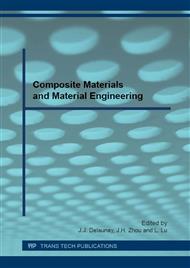p.92
p.97
p.101
p.105
p.111
p.117
p.121
p.125
p.135
Assessment of Titanium Carbide Chlorination by Statistical Design
Abstract:
In present study, the effects of the process parameters on chlorination of Titanium Carbide (TiC) was studied. Besides that, process parameters were investigated by using experimental design of experiment (DOE) and statistical analysis. The chlorination of the samples was carried out at temperatures between 400 to 500°C. Effects of three parameters, namely temperature, soaking time, and molar ratio of potassium permanganate (KMnO4) to hydrochloric acid (HCl) were investigated. The interaction, on the rate of chlorination of TiC were statistically evaluated by using DOE. The weight loss (wt. %) was the main response taken into account in this paper. The results of the experimental design indicated that the main significant factor for chlorination of TiC was higher temperature, soaking time and higher molar ratio of KMnO4 to HCl. DOE results have demonstrated that the highest extent of chlorination obtained at the highest weight loss (wt. %) was about 54.59 wt. % at 500°C with a soaking time of 180 minutes and KMnO4 to HCl molar ratio of 0.17 respectively. The amounted to a titanium extraction of about 96.39 %. On the other hand, the lowest wt. lost was 30.76 wt. % and this was obtained at 500°C for 120 minutes with KMnO4 to HCl molar ratio of 0.09 respectively. The results obtained from this work will be employed as a guide for the future studies on chlorination of nitrided/carburized Malaysian ilmenite or titanium oxycarbonitride. The final aim was to produce TiCl4 at low temperatures (≤500°C) using the latter samples. The experimental values are in good agreement with calculations from the statistical model.
Info:
Periodical:
Pages:
111-114
Citation:
Online since:
July 2016
Authors:
Keywords:
Price:
Сopyright:
© 2016 Trans Tech Publications Ltd. All Rights Reserved
Share:
Citation:


